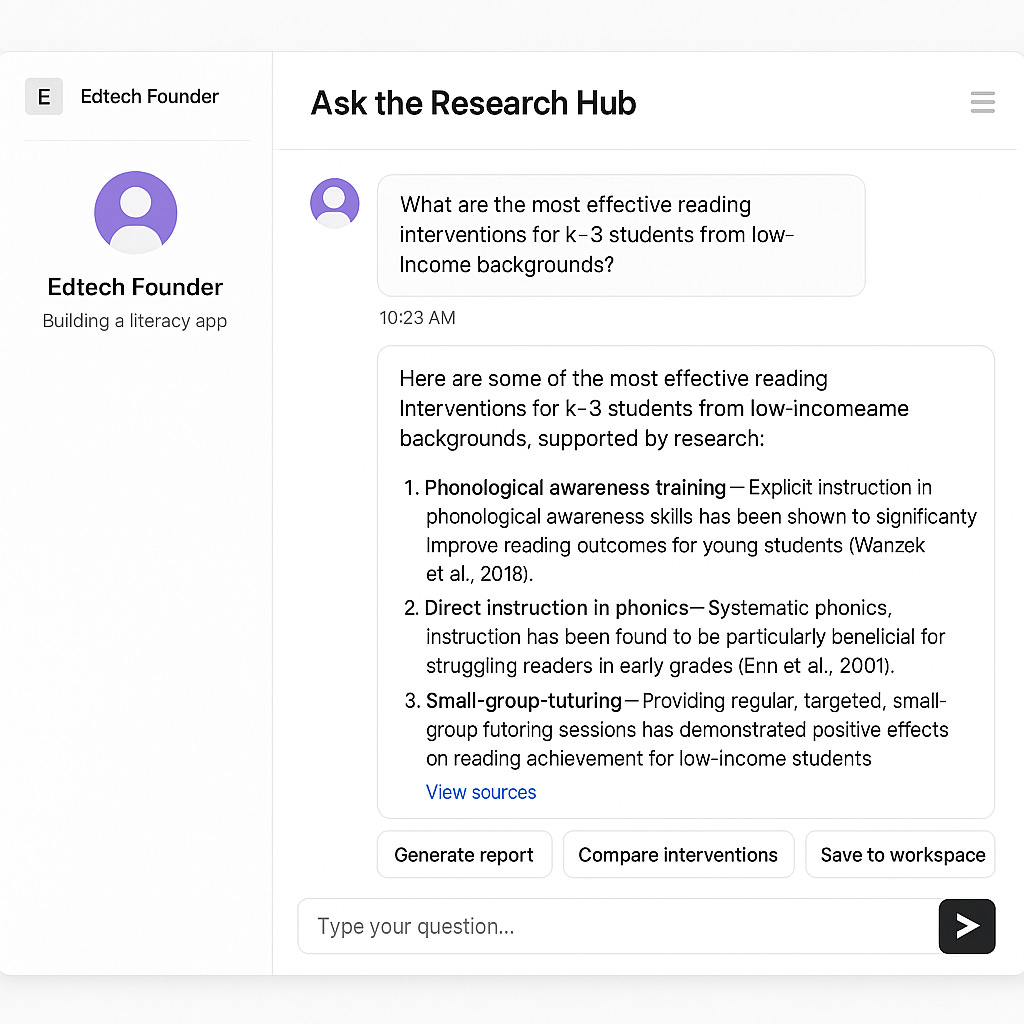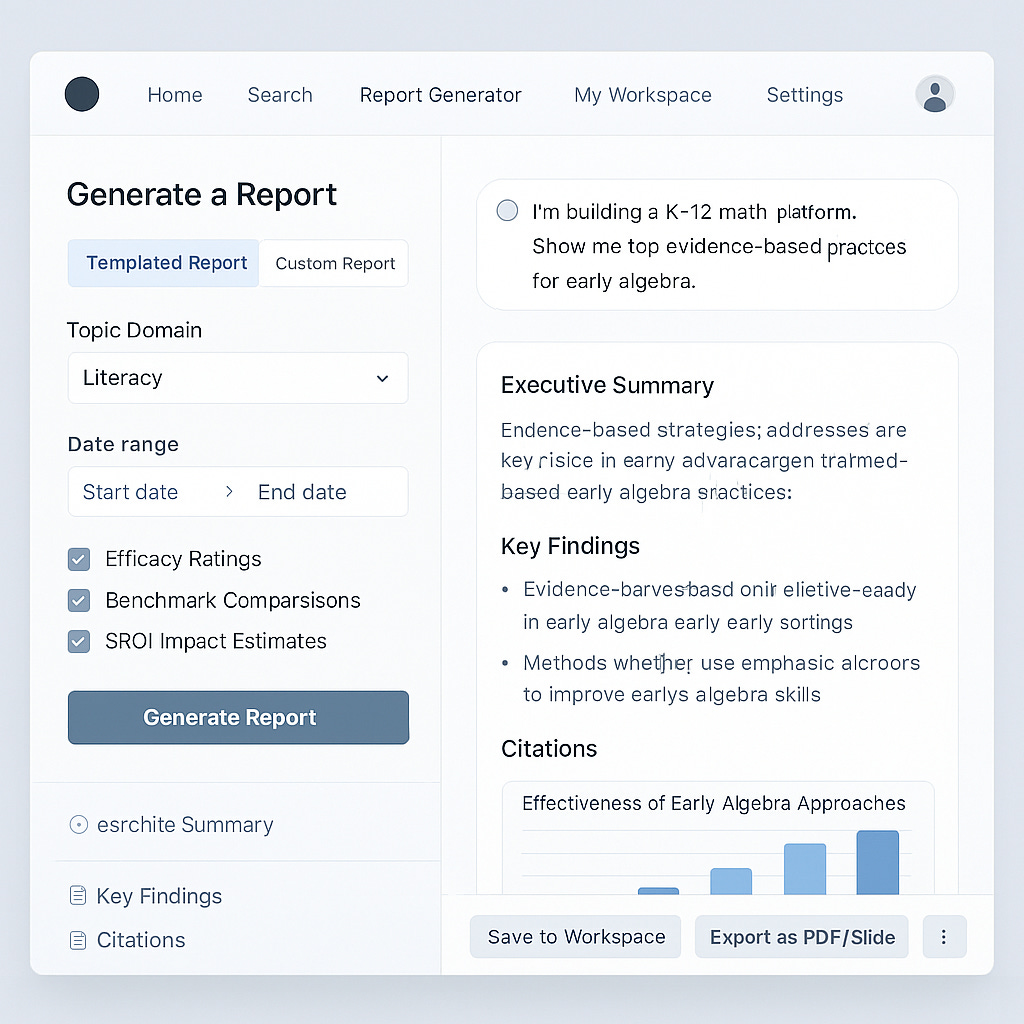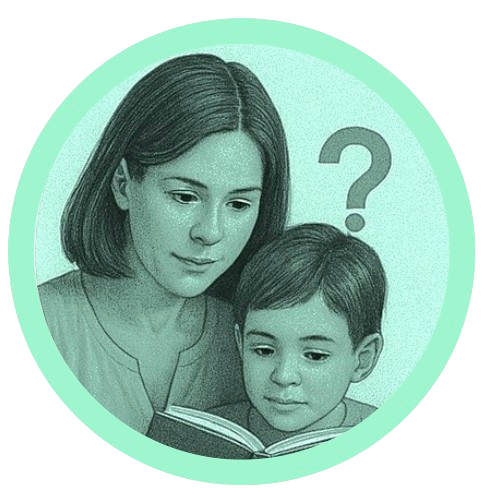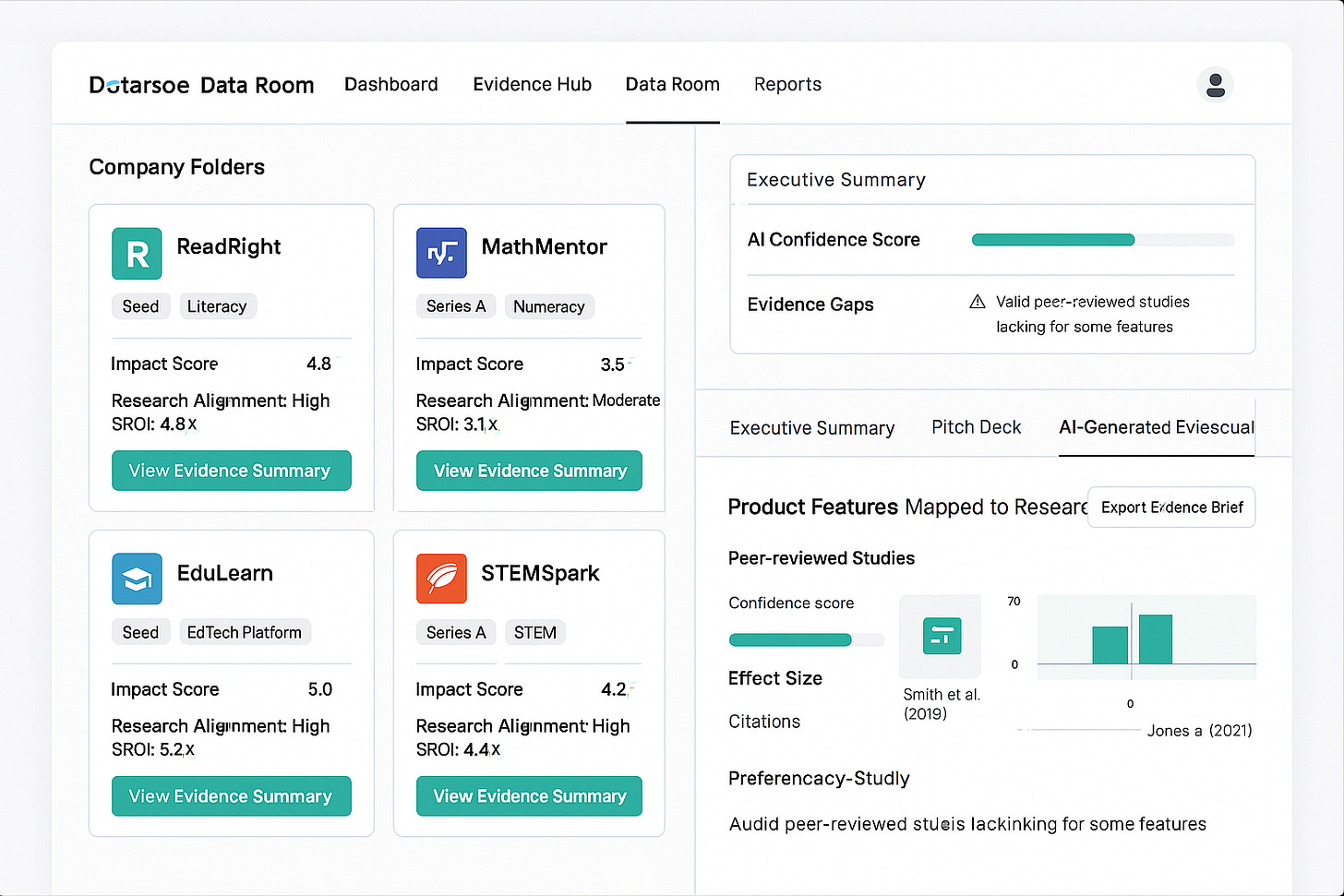Can AI Bridge Education's Research-Practice Gap? A Vision For The Learning Science Evidence Hub
From Venture to Learn, Learn Capital's exploration of the future of education.
Despite decades of research on effective learning methods, there remains a significant gap between research findings and classroom practices. Our proposed Evidence Hub would use AI to bridge this gap, helping stakeholders make decisions based on solid evidence rather than trends or assumptions.
Evidence Hub Summary
We envision creating the Learning Science Evidence Hub - think of it as "ChatGPT meets JSTOR" for education. This AI-powered tool would make research accessible to everyone involved in education: teachers, parents, app developers, and investors.
Education faces critical challenges in 2025: students are still recovering from pandemic learning losses, schools are adopting more technology (though only 25% of popular edtech products meet research standards), budgets are tightening, AI is rapidly changing the landscape, and families have unprecedented school choice options.
The platform would feature a carefully curated collection of the most promising and proven learning science research, organized to make insights easily discoverable. Users could ask questions in conversational language and receive research-backed answers. Teachers could find effective teaching strategies, parents could identify quality programs for their children, developers could create evidence-based products, and investors could fund truly impactful innovations.
Get Involved! Want to help build the Learning Science Evidence Hub? Contact us through our interest form.
The Critical Moment: Why Now?
Education stands at a critical inflection point in 2025. Despite vast amounts of learning science research, front-line educational decisions—from classroom instruction to edtech investments—often overlook this evidence. The result is a persistent gap where proven innovations languish while unproven ones proliferate, contributing to stagnant outcomes and persistent inequities.
Several converging trends have created both urgency and opportunity to close this evidence gap:
Headwinds
Post-Pandemic Learning Recovery: Student achievement is still recovering nearly five years after COVID-19 upended schooling. The U.S. poured roughly $190 billion into academic recovery, but students still have a long way to go. Every intervention must count, and evidence-based approaches are essential to maximize limited resources.
Explosion of Unvalidated EdTech: The average school district now accesses nearly three times as many edtech products per month as it did pre-pandemic. Yet only 25% of the 100 most-used K-12 edtech products meet federal research quality standards. We risk wasting time, money, and student potential if we don't rapidly assess what works.
Challenging Fiscal and Demographic Trends: Slowing enrollment in many districts, declining birth rates, and tightening public budgets are pressuring schools to do more with less. These trends compound the urgency of ensuring every dollar supports interventions with proven impact.
Tailwinds
The Rise of Generative AI in Education: From AI tutors to writing assistants, schools are rushing to integrate AI into classrooms. Yet research on GenAI's educational impact is in its infancy, with many teachers remaining skeptical. There's a narrow window to shape how AI is applied to learning, ensuring it becomes an evidence-informed boon rather than a hype-driven distraction.
Expanding Parental Choice in Education: Families have more educational options than ever, with Education Savings Accounts (ESAs) surging from just four states in 2019 to 18 in 2024. Over one million students now participate in a private school choice program. And more than 20 million children are now eligible to use a share of their education funding to pay for tuition or customize their education. New schools and learning providers are emerging to meet growing parental demand. However, virtually no rigorous research on the outcomes of these programs exists yet. Families and policymakers operate in the dark, risking a "Wild West" where success is hit-or-miss.
A growing national support for evidence-based practices. More than two dozen states have enacted laws to require the “Science of Reading” and evidence-based best practices used in the classroom, with some encouraging results.
Federal Context and the Evidence Imperative
In 2025, the U.S. education system stands at a crucial crossroads. Public policy and private capital are increasingly aligned around funding what works, with a growing emphasis on measurable outcomes and evidence-based practice. However, just as this alignment is beginning to take shape, the nation's education research infrastructure is facing unprecedented strain.
In early 2025, the U.S. Department of Education canceled $900 million in IES research contracts, prompting widespread concern across the education research community. The cancellations are part of the Trump administration’s planned closing of the Department of Education, which some view as streamlining efforts, but which many researchers warn could undermine essential research infrastructure. If enacted, these reductions would limit the ability of researchers and policymakers to measure progress, identify disparities, and improve outcomes, especially for underserved student populations.
Too often, the public education sector has overlooked evidence-based best practices identified through federally funded education research, despite Congress and the Department of Education establishing a “What Works Clearinghouse" and funding research centers to encourage implementation. For example, the widespread use of ineffective reading instruction methods in school districts across the United States followed the release of a Congressionally-mandated report with comprehensive recommendations for effective reading instruction.
This is the inflection point: we can either allow our evidence ecosystem to erode under the weight of funding uncertainty or partner with government and key stakeholders to reimagine and reinvest in new knowledge infrastructures that serve the needs of a rapidly evolving education system.
Yet within this tenuous moment lies a powerful opportunity. The Department of Education continues to operate under frameworks prioritizing proven interventions, with ESSA's tiered evidence requirements shaping how billions in federal dollars are allocated. Meanwhile, education research funding faces efficiency pressures, with calls to streamline how research translates to practice.
This creates a fundamental tension: How can we maintain rigorous evidence standards while making the research enterprise more efficient and impactful?
The potential for research and evidence has never been greater in 2025. The historic decentralization underway across the United States creates opportunities for parents to demand effective teaching methods from schools. Many parents can now use state funding to access educational technologies and services to customize their child’s education.
Why the Research-Practice Gap Persists
Despite decades of calls for "evidence-based education," a significant divide remains between research and practice due to several persistent barriers:
Translation Challenge: Research findings rarely arrive in formats educators can readily apply. Dense academic language and a lack of practical context make breakthrough insights inaccessible.
Information Overload: Education research output has exploded, but practitioners lack efficient ways to filter, synthesize, and prioritize findings relevant to their contexts.
Misaligned Incentives: Researchers are rewarded for peer-reviewed publications, not practical impact. Meanwhile, education markets often value user growth and engagement over demonstrated learning outcomes.
Implementation Complexity: Even when evidence is clear, translating it into effective practice requires contextual adaptation and ongoing refinement, which most educators lack the support to undertake.
Stakeholder preferences: Education institutes have not always prioritized evidence-based methods in the classroom.
Current solutions—like the What Works Clearinghouse or product certifications—offer partial remedies but fail to integrate seamlessly into stakeholders' daily decision-making processes.
Introducing the Learning Science Evidence Hub
This powerful AI system combines the conversational accessibility of modern language models with deep access to the world's education research. It's an AI-driven platform that maps what the research says and continually updates based on new data and user feedback.
The Learning Science Evidence Hub can be envisioned as ChatGPT meets JSTOR.
At its core, the Learning Science Evidence Hub is a next-generation knowledge platform that democratizes access to learning science research. It transforms dense academic findings into practical, actionable insights for anyone making educational decisions—from classroom teachers to product developers, parents to policymakers.
The Hub isn't just a database or search engine. It's an intelligent system that understands context, synthesizes across studies, and translates complex research into clear recommendations tailored to specific situations and needs.
Core Functions
Research Access: Breaks down paywalls and technical language barriers to make academic content accessible to all educational stakeholders.
Contextual Relevance: Matches research findings to specific scenarios and contexts, ensuring practical application.
Cross-Study Synthesis: Analyzes and combines findings from multiple research sources to identify patterns, consistencies, and contradictions in educational evidence.
Implementation Guidance: Explains real-world application with concrete steps for translating research into practice.
Continuous Learning: Refines understanding through feedback loops that capture implementation data.
User Interfaces
Evidence Query Chatbot: Plain language questions with research-backed answers
Evidence Aligner: Analyzes user materials against research
Custom Reports: Structured evidence summaries and benchmarking
Stakeholder Use Cases
Let's explore how different education stakeholders could use the Hub:
EdTech Founder
Designing with Learning Science from Day One
What does research say about teaching fractions to 7th graders?
Which engagement strategies have the most substantial evidence for middle school math?
How does my product's approach compare to research-backed methods?
What outcome measures should I use to demonstrate effectiveness?
Parent
Choosing What's Best for My Child
What reading programs work best for 4th graders with dyslexia?
Is this after-school program using evidence-based methods?
How much daily reading is optimal for my 2nd grader?
What questions should I ask about my child's math curriculum?
District Leader
Data-Driven Decisions for Student Achievement
Which curricula have the most substantial evidence for our student demographics?
What are the most effective approaches to reduce chronic absenteeism?
How do our implementation practices compare to research recommendations?
What professional development models show the most substantial impact on teacher effectiveness?
Impact Investor
Education Outcomes as the New Bottom Line
How does this startup's approach align with learning science research?
What benchmarks should we set for learning gains in this domain?
Which outcome measures are most meaningful for this type of intervention?
How does this company's early evidence compare to similar solutions?
Under the hood, the Hub leverages state-of-the-art AI techniques:
Retrieval-Augmented Generation (RAG): Instead of relying on a static model, the Hub employs RAG to combine AI with a curated research database. When a user poses a question (e.g., "What is the impact of daily reading homework at the 2nd grade level?"), the system retrieves relevant documents from its knowledge base and synthesizes an answer grounded in those sources, complete with references.
AI + Human Expertise: The platform combines sophisticated AI processing with expert human oversight to ensure accuracy, relevance, and quality of all generated content.
Dynamic Knowledge Base: The platform continuously updates with new research findings through validated data ingestion processes. All sources are cataloged with metadata on quality and context, allowing the AI to weigh the strength of sources appropriately.
Reinforcement Learning from Human Feedback (RLHF): The quality of AI-generated answers is actively refined through expert human review. A network of vetted educators, researchers, and specialists periodically reviews the AI's outputs for accuracy, completeness, and bias. Their feedback is fed back into the model training loop.
Comprehensive Evidence Database: A rich, multidisciplinary library of sources, including peer-reviewed articles, meta-analyses, program evaluations, and more. By aggregating disparate sources, the Hub breaks down information silos.
Bidirectional Learning: The system delivers research insights and gathers implementation data from users, creating a feedback loop that improves recommendations and informs future research priorities.
AI Advantages Over Traditional Repositories
Contextual Understanding: Comprehends educational contexts, not just keywords
Cross-Study Synthesis: Integrates findings to identify patterns and consensus
Adaptive Responses: Adjusts detail based on user expertise
Implementation Focus: Identifies context variables affecting success
Dynamic Evolution: Continuously updates with new research and user feedback
This approach resolves the fundamental tension in education evidence: maintaining rigorous standards while making research accessible enough to influence real-world decisions. Rather than replacing traditional research or evidence frameworks, the Hub augments them, creating a force multiplier that helps federal investments in education research reach more practitioners and influence decisions.
Vision & Impact: Transforming Education
If successful, the Learning Science Evidence Hub could drive several transformative shifts:
Capital Flows Toward Impact: With transparent evidence on what works, investors will increasingly direct funds to programs and companies that demonstrate tangible results.
Faster Adoption of Evidence-Backed Innovation: The Hub can dramatically shorten the time between discovery and implementation, from decades to months, while ensuring that only proven innovations spread widely.
Elevated Professional Culture for Educators: Teachers could participate actively in a learning science community, trying evidence-based strategies, measuring outcomes, and sharing field feedback. Teaching would become less isolated as decisions would be informed by collective intelligence.
Improved Student Outcomes at Scale: We should see measurable gains in key outcomes by systematically applying proven interventions. Achievement gaps should narrow as more schools, including high-poverty ones, adopt high-impact strategies.
A Learning Culture Beyond School: The culture of evidence could extend to lifelong learning and public mindset, with parents consulting research on child development and employers using evidence to shape workforce training.
Get Involved
We're inspired by the Learning Science Evidence Hub's potential to bridge the gap between research and real-world practice, but we know we can't do it alone. To realize this vision, we need insight, partnership, and creativity from the education ecosystem.
Are you a..
Foundation eager to fund catalytic infrastructure?
Technologist interested in building responsible AI for the public good?
Educator or instructional leader who wants to ensure relevance in the classroom?
Researcher or learning designer passionate about connecting evidence to impact?
Policy advisor, district leader, or advocacy organization shaping decisions at scale?
Parent, investor, or professional development leader seeking trusted, actionable insight?
This is an open call to co-develop a tool that works for you—and with you. We're assembling a coalition to build, prototype, test, and refine the Evidence Hub over the coming year. Together, we can create something both practical and transformative.
Learn Capital's Commitment
We are committing to convening partners and garnering resources to build the prototype Evidence Hub in the coming year. We pledge to prioritize evidence in our investment processes. We'll measure our success not just by financial returns but also by the learning outcomes achieved through the innovations we back.
Education is everyone's business—it shapes our future workforce, citizens, and leaders. By aligning our efforts, sharing what we know, and wisely embracing innovation, we can ensure that education becomes a proper learning system that gets smarter over time. Let's bridge the gap and usher in a new era where the full strength of our knowledge supports every learner's potential.
Join the Conversation
What role do you see evidence playing in education's future? How might an AI-powered evidence hub change your work? We'd love to hear your thoughts in the comments below.
Subscribe to Venture to Learn for more insights on the future of education and learning science.








